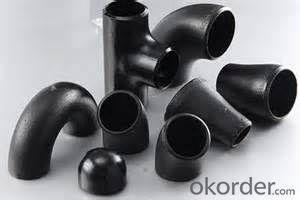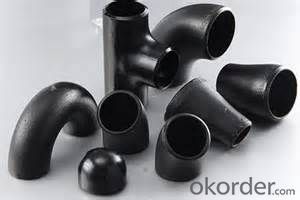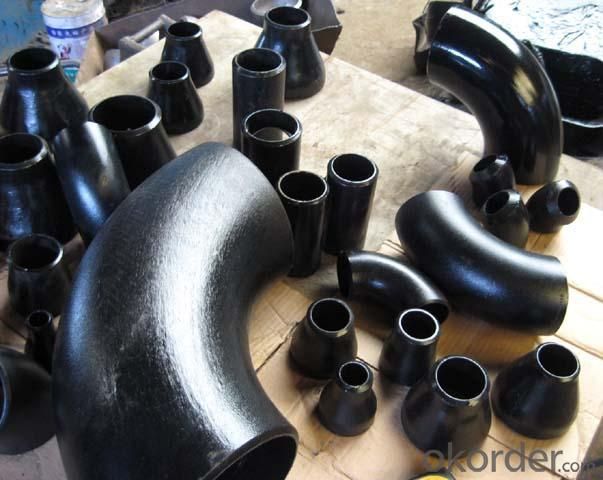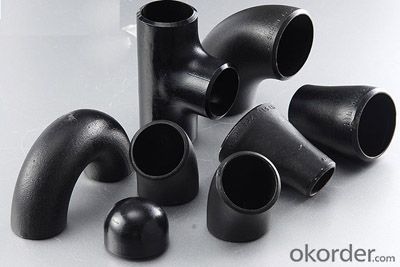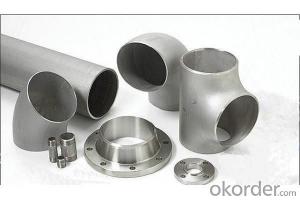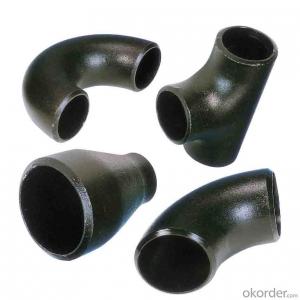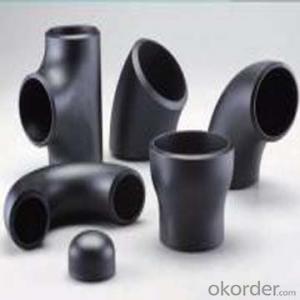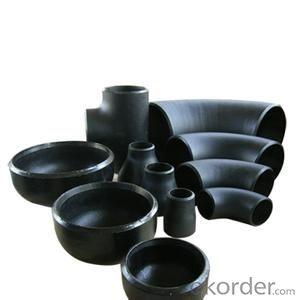Carbon Steel Tee in High Demand of Ansi b16.9 A234
- Loading Port:
- Tianjin
- Payment Terms:
- TT OR LC
- Min Order Qty:
- 100 m.t.
- Supply Capability:
- 1000 m.t./month
OKorder Service Pledge
OKorder Financial Service
You Might Also Like
Product Description:
1、Structure of Ansi b16.9 A234 Wpb Carbon Steel Tee Description:
Carbon Steel Tee made by us are perfectly in accordance with the technical specifications provided by the client. These tee are highly durable and are used to connect two or three pipes together. All these tee are light in weight and are made of high quality carbon steel.
2、Main Features of Ansi b16.9 A234 Wpb Carbon Steel Tee :
relatively light weight
optional torsional strength
support high pressure
resist corrosion
reasonable price
3、Ansi b16.9 A234 Wpb Carbon Steel Tee Images:
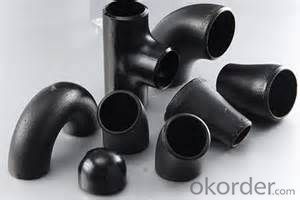
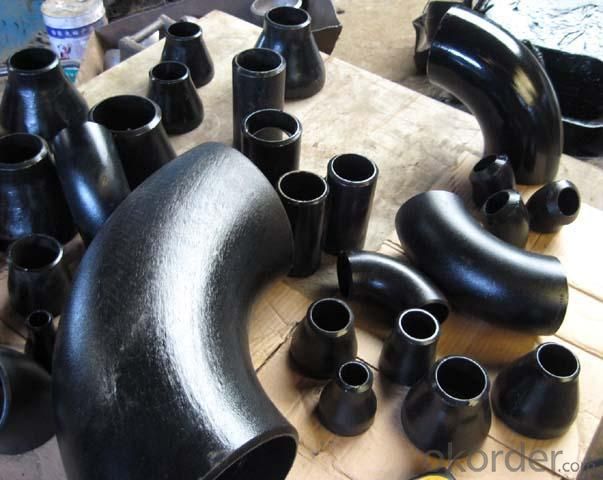
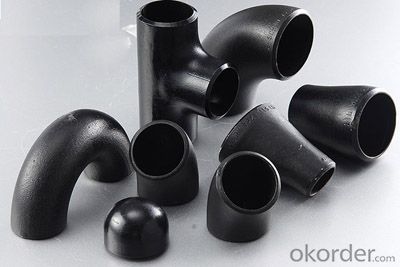
4、Ansi b16.9 A234 Wpb Carbon Steel Tee Specification:
low carbon steel tee
1 type: equal/reducing tee
2 size: DN15~DN1800
3.Thickness : 2.8~60mm.
4.standard : ans/din/gost/en/bs.
Elbow | DN15~DN1800 |
Flange | DN15~DN4000 |
Tee | DN15~DN1800 |
Reducer | DN15~DN1800 |
Cap | DN15~DN1800 |
Seamless Steel pipe | DN15~DN600 |
ERW | DN15~DN1800 |
SSAW | DN200~DN3600 |
LSAW | DN300~DN1400 |
Wall thickness | SCH10-XXS |
Carbon steel elbow | |
Other productions: | butt welded and seamless pipe fittings ,steel pipe such as tee, cross, cap, bend, 45D/90D/180D LR/SR elbow. |
Material: | Carbon steel/alloy steel /stainless steel elbow |
Size: | Seamless elbow:1/2"~24" DN15~DN600 |
Welded Elbow: 1/2”~72" DN15~DN1800 | |
Thickness: | SCH10~SCH160,STD ,XS ,XXS sch5s, sch20s, sch40s, sch80s,SGP. |
Surface treatment: | Transparent oil, rust-proof black oil hot/cold galvanized |
Productivity: | 1000 T/month |
Min order: | 100pieces |
Delivery Term: | FOB(30deposite the balance before shipment) CIF or C&F(30% deposite, the balance against with the copy of B/L) |
Remark: | 1. Special design available according to requirement 2. All the production process are made under the ISO9001:2000 ,API. |
5、FAQ of Ansi b16.9 A234 Wpb Carbon Steel Tee:
①How to guarantee the quality of the products?
We have established the international advanced quality management system,every link from raw material to final product we have strict quality test;We resolutely put an end to unqualified products flowing into the market. At the same time, we will provide necessary follow-up service assurance.
②How long can we receive the product after purchase?
In the purchase of product within three working days, We will arrange the factory delivery as soon as possible. The pecific time of receiving is related to the state and position of customers.
③ How can we get more information?
You can contact us by Email or call us directly and we will do our best to give you valuable information as much as possible but this service is not available on weekends.
- Q: How are steel pipes used in the manufacturing of shipbuilding and offshore structures?
- Steel pipes are widely used in the manufacturing of shipbuilding and offshore structures due to their high strength and durability. These pipes are used for various purposes such as constructing the hull of the ship, creating structural supports and framework, and facilitating the transportation of fluids and gases. Their corrosion-resistant properties and ability to withstand extreme conditions make steel pipes an ideal choice for these applications.
- Q: Can steel pipes be used for underground culverts?
- Yes, steel pipes can be used for underground culverts. Steel pipes are commonly used for underground culverts due to their strength, durability, and resistance to corrosion. They provide a reliable solution for conveying water or other fluids underground, ensuring efficient drainage and water management systems.
- Q: How do steel pipes handle extreme weather conditions?
- Steel pipes are highly durable and can withstand extreme weather conditions. They have excellent resistance to corrosion, making them suitable for humid and coastal areas. Additionally, steel pipes can withstand high temperatures, making them reliable in extreme heat or cold. Their strength and resilience make them ideal for various applications, including oil and gas pipelines, water supply systems, and construction projects in harsh weather environments.
- Q: What is the role of steel pipes in the transportation of liquefied natural gas (LNG)?
- Due to their unique properties and characteristics, steel pipes are essential in the transportation of liquefied natural gas (LNG). LNG is a form of natural gas that is cooled to a liquid state for easier transportation and storage. Specific infrastructure is required for the transportation of LNG, and steel pipes are a crucial part of this infrastructure. To begin with, steel pipes are used in the construction of LNG terminals and liquefaction plants. These facilities are responsible for converting natural gas into its liquid form and storing it prior to transportation. The extremely cold temperatures needed to maintain LNG in its liquid state necessitate the use of materials that can withstand these conditions, and steel pipes are well-suited for this purpose. Steel pipes possess excellent strength and durability, enabling them to handle the low temperatures and high pressures involved in the liquefaction and storage processes. Additionally, steel pipes are employed in the transportation of LNG from the liquefaction plants to the storage tanks or shipping vessels. LNG is typically transported over long distances, either through pipelines or specialized LNG carriers. Steel pipes are utilized in the construction of underground or above-ground pipelines, providing a reliable and safe means of transporting the LNG. The pipes must be capable of maintaining the low temperatures of the LNG while enduring the pressures and stresses associated with the transportation process. Steel pipes offer the necessary strength, corrosion resistance, and thermal properties to ensure the safe and efficient transportation of LNG. Finally, steel pipes are also utilized in the construction of storage tanks for LNG. These tanks are designed to keep the LNG in its liquid state until it is ready for use or further transportation. The tanks are often constructed using a combination of steel plates and steel pipes. Steel pipes are employed to connect the various components of the tank, such as the inner and outer shells, reinforcing the structural integrity of the tank and guaranteeing its ability to withstand the extreme conditions to which it is exposed. In conclusion, steel pipes are vital in the transportation of liquefied natural gas (LNG) due to their strength, durability, and ability to endure low temperatures and high pressures. From the construction of LNG terminals and liquefaction plants to transportation through pipelines or specialized vessels, steel pipes are a crucial component of the infrastructure required for the safe and efficient transportation and storage of LNG.
- Q: How do you calculate the pipe pressure drop coefficient for steel pipes?
- To calculate the pipe pressure drop coefficient for steel pipes, you can use the Darcy-Weisbach equation, which takes into account factors such as the pipe length, diameter, roughness, and fluid flow rate. The coefficient can be determined using empirical correlations or charts based on these parameters, ensuring accurate estimation of pressure drop in steel pipes.
- Q: Can steel pipes be used for water supply lines?
- Yes, steel pipes can be used for water supply lines. Steel pipes are durable and have high tensile strength, making them suitable for carrying water. However, it is important to ensure that the steel pipes are properly treated to prevent corrosion and rusting.
- Q: What are the environmental impacts of steel pipe production and disposal?
- Significant environmental impacts are associated with the production and disposal of steel pipes. First and foremost, the production of steel pipes necessitates the extraction of raw materials such as iron ore, coal, and limestone. This extraction process leads to the destruction of habitats, deforestation, and soil erosion. Furthermore, mining and processing these materials require a substantial amount of energy, often derived from fossil fuels, which contributes to the emission of greenhouse gases and air pollution. The manufacturing process itself encompasses various stages, such as melting, casting, rolling, and coating, all of which demand considerable energy inputs and emit substantial quantities of carbon dioxide and other greenhouse gases. Additionally, the production of steel pipes involves the utilization of chemicals and additives that can pose harm to the environment if not properly managed. Moreover, if steel pipes are not recycled or appropriately dealt with during disposal, they can end up in landfills, thus contributing to waste accumulation and occupying valuable space. Steel is typically non-biodegradable and can take hundreds of years to decompose. When steel pipes are dumped in landfills, they can release toxic substances and heavy metals, which can contaminate soil and groundwater. Nevertheless, it is important to acknowledge that steel pipes are highly recyclable, and recycling them significantly mitigates the environmental impact. Recycling steel pipes aids in the conservation of natural resources, reduces energy consumption, and lowers greenhouse gas emissions. Additionally, using recycled steel in the production of new pipes requires less energy and results in fewer emissions compared to using virgin materials. To minimize the environmental impacts of steel pipe production and disposal, it is crucial to advocate sustainable practices throughout the entire lifecycle of the product. This entails reducing energy consumption, utilizing renewable energy sources, implementing proper waste management strategies, and encouraging the recycling and reuse of steel pipes.
- Q: Seamless steel pipe 8162 and 8163 what is the difference?
- GB 8162 is the structure of the tube, there is no need for flaw detection, the use of mechanical processing, stents;
- Q: What are the different types of valves used with steel pipes?
- There are several types of valves commonly used with steel pipes, including ball valves, gate valves, globe valves, check valves, and butterfly valves. These valves serve different purposes and have various designs, such as quarter-turn operation for ball valves, wedge-shaped gates for gate valves, and disc-shaped elements for butterfly valves. Each type of valve offers specific advantages and is selected based on the application requirements and the flow control needs of the steel pipe system.
- Q: Do steel pipes expand or contract with temperature changes?
- Steel pipes expand with temperature increases and contract with temperature decreases.
Send your message to us
Carbon Steel Tee in High Demand of Ansi b16.9 A234
- Loading Port:
- Tianjin
- Payment Terms:
- TT OR LC
- Min Order Qty:
- 100 m.t.
- Supply Capability:
- 1000 m.t./month
OKorder Service Pledge
OKorder Financial Service
Similar products
Hot products
Hot Searches
Related keywords
